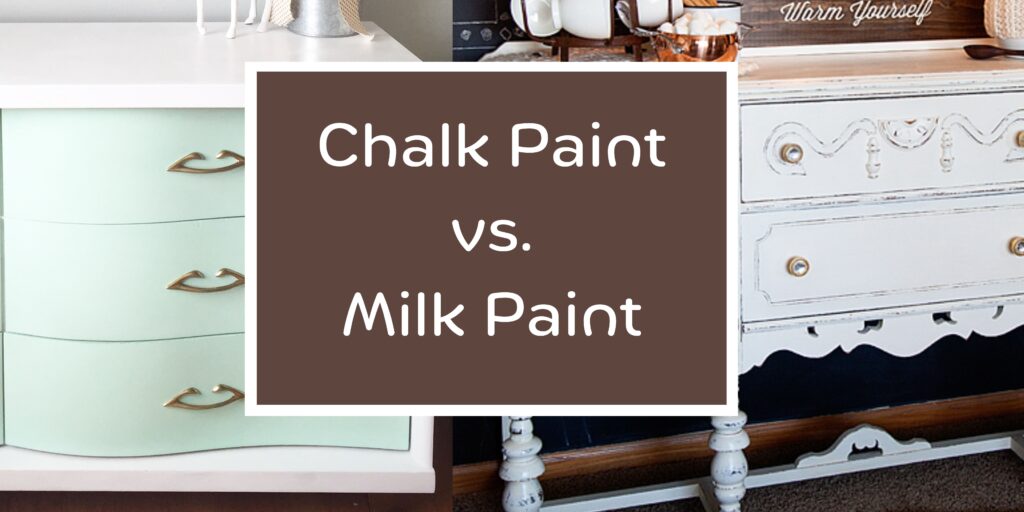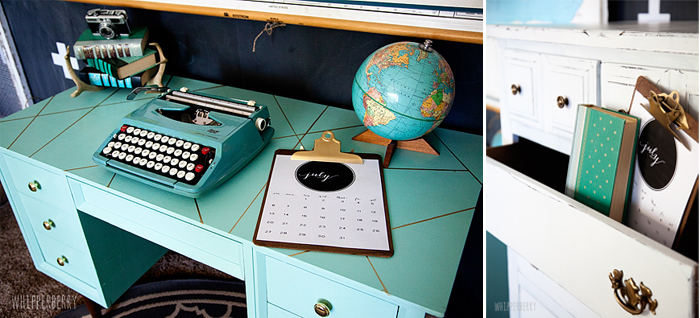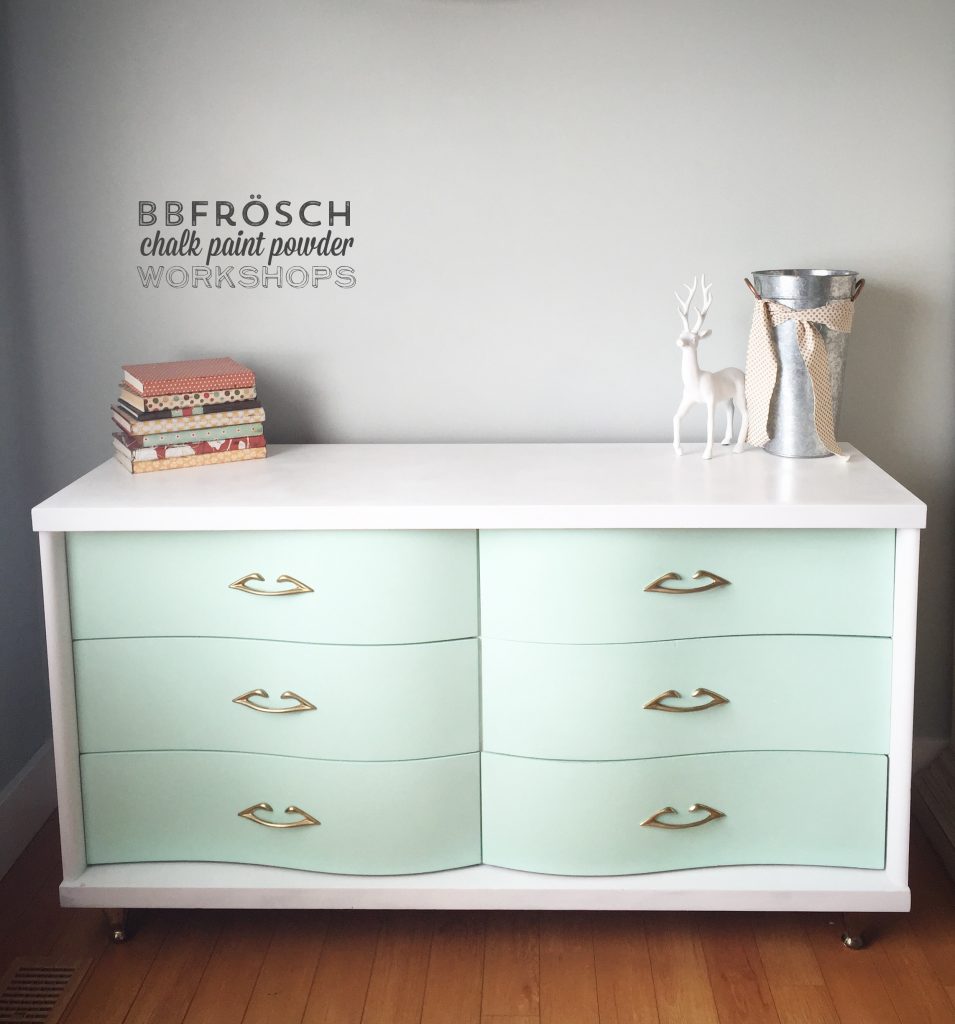Milk paint and chalk paint seem very similar and it can be hard to tell the difference. I’m going to clear this up for you in the quickest way possible and also provide some more in-depth information for you.
If you’re a fan of the “farmhouse” or “country chic” home decor styles like me, you’ve undoubtedly noticed the trend of refinishing furniture and home accessories with colorful matte finish paints.
Chalk paint and milk paint are the two most popular products to achieve this look. One may be better than the other depending on what you’re painting. The best paint for cabinets may be different than the best paint for furniture.
Have you wondered what the difference is between these two paint products? They’re very similar but have some significant differences.
Key Takeaways:
Chalk paint and milk paint are very similar but with a few key differences. However, milk paint can leave brush strokes and add texture. Chalk paint is thicker and covers textured surfaces better. Use milk paint if you want the outcome to look aged or rustic because it keeps textures. The brand I recommend is Rust-Oleum Milk Paint.
What Is Milk Paint?
Modern milk paint is still made with milk protein (casein). It is sold in a powdered form, instead of a ready-to-use liquid. To use it, you’ll need to mix the powder with an equal amount of water.
Then, you need to let the paint sit for a few minutes to allow any bubbles to dissolve. Freshly mixed milk paint might have a slight odor that is described as “milky” or even “grassy”, but the scent completely vanishes once the paint dries.
You shouldn’t mix up too much milk paint at one time, as it has a relatively short shelf life once mixed. It will only be good for a few days to a week if kept in a sealed container.
You can extend the shelf life a little bit by keeping your mixed paint in the refrigerator. The milk paint powder, however, should be good for years as long as it is kept dry.
Milk paint is one of the most environmentally friendly paints you can buy. It is water-based, non-toxic, and completely free of volatile organic compounds (VOCs).
It’s also easy to create custom colors with milk paints, as you can easily combine the different pigments and then mix them with water.
Milk paint is a little bit thinner than chalk paint, so it can be used as a “wash” to allow wood grain details to show. To achieve a smooth, opaque finish, two or even three coats (depending on your surface) are needed.
Fortunately, milk paint dries very quickly so it doesn’t take much time to cover something with multiple coats of paint. The end result is a mostly matte finish with a very slight velvety sheen.
Brief History of Milk Paint
Milk paint has been around in some form for literally thousands of years. In fact, when the ancient Egyptian tomb of King Tutankhamun was discovered in 1924, some of the artifacts recovered were found to have been painted with milk paint.
The earliest forms of milk paint were made simply of milk, lime, and natural pigments made from plants or minerals.
What Is Chalk Paint?
Chalk paint is a decorative paint first invented by designer Annie Sloan in 1990. In fact, the term “chalk paint” is a registered trademark for that company. Since 1990, many other paint companies have created their version of chalk paints.
Chalk paint is a water-based, non-toxic paint that dries to a smooth, completely matte, “chalky” finish. Once it dries, there is absolutely no sheen to it at all.
This finish is achieved by the addition of minerals to a basic paint formula. It’s a popular choice for anyone who wants to transform an old piece of wood furniture or to create a “distressed” appearance on an object.
Chalk-style paint is easy to apply and comes ready to use. Other than stirring it a bit like you would any other paint, you can paint with it as soon as you open the can.
It will adhere to just about any porous surface without the need for any sanding. If you want to use it on a shiny or varnished surface, a little bit of light sanding will help the paint stick. The coverage is smooth, and for many projects, only one or two coats of paint are needed.
Much like milk paint, chalk-style paint is very environmentally friendly. It is water-based, non-toxic, and has a very low amount of volatile organic compounds. Some brands of chalk-style paint have a low odor, but it disappears when the paint is dry.
Something interesting is you can even make your own chalk paint. There are two ways to do it. One is with BB Frosch and the other is your own homemade chalk paint recipe.
Uses For Milk Paint
Milk paint adheres to just about any porous surface. If you want to paint something that has a shiny surface, or wood with varnish on it, just lightly sand it and the milk paint should adhere with no problem.
Milk paint is a great choice for furniture, glass, and metal pieces. It is more difficult to get a distressed look on furniture than when using chalk-style paint, but it’s durable enough that you don’t necessarily have to use a finish coat with it.
Milk paint is also a good paint to use for cabinet doors, wood trim and framework, or even interior walls in your home. It holds up well to any piece that will be touched frequently.
Because milk paint is thinner than chalk paint, you’ll need to use at least two coats if you want opaque coverage. A single coat of milk paint will be semi-transparent and can be a lovely way to highlight wood grain and textures.
Is Milk Paint Durable?
Milk paint is incredibly durable. The casein proteins and lime in the paint dry to form an impressively hard bond to whatever surface they’re in contact with.
Once you complete painting something with milk paint, the finish will stay vibrant for years. It shouldn’t chip (unless you purposely distress it) and the colors won’t fade significantly over time.
It’s a great choice if you want a matte finish on surfaces that will be touched quite a bit.
Usually, it isn’t necessary to apply any top coat to surfaces painted with milk paint, but if you want a top coat, an oil-based product such as tung oil is preferable to a finishing wax. Be sure to let the paint dry for at least 24 hours before finishing with any oil products.
Milk Paint vs Chalk Paint On Kitchen Cabinets
Both milk paint and chalk paint can make your kitchen cabinets look great. If your kitchen has a “farmhouse chic” decorating theme, either of these paints will look fabulous.
However, milk paint has a slight advantage over chalk-style paint if you’re going to paint your cabinets. That advantage comes down to the durability of milk paint.
Chalk paint on cabinets will look great at first, but it won’t be long before it will start to show some wear and tear. If you choose to use chalk-style paints on cabinet doors, you will definitely need to apply a finishing wax top coat.
This will help your chalk-style paint last longer, but your paint job won’t look quite as perfectly matte on the surface. Even with a wax top coat, the wax will periodically need to be refreshed.
Milk paint is a better choice for cabinet doors. You’ll still have a mostly matte finish with just a slight sheen, but you’ll also have increased durability. Since cabinet doors are something that will frequently be moved and touched, you need paint that can handle a lot of use.
Milk Paint vs Chalk Paint For Furniture
Deciding whether to use milk paint or chalk-style paint on a piece of furniture really depends on what you want your finished piece to look like. Both paints are good choices for transforming wood furniture into eye-catching vintage-style pieces.
Because milk paint is thinner than chalk-style paint, you can use one or two coats to give furniture a “washed” appearance. This is a good way to highlight any piece with attractive wood grain. If you want a more opaque finish, you can apply more coats of milk paint, allowing time to dry between each coat.
Because milk paint is so highly durable, you can get away with not needing a sealant over your paint. The paint will last for years and the colors stay beautifully vibrant.
It’s possible to get a “distressed” or “chippy” look with milk paint, but it takes a little more work than with chalk-style paint. Because milk paint dries to such a hard finish, it’s more challenging to sand or chip it away.
Try sanding your furniture before the milk paint is fully dry to make it easier.
Chalk-style paint, on the other hand, distresses beautifully with just a bit of light sanding. It’s easy to bring out carved details or wood grain when using chalk-style paints. Chalk paint also goes on smoothly, with even coverage. However, if your painted furniture will be something that gets touched a lot, you will need to apply a wax sealant coat over chalk-style paint to protect it.
Milk Paint Brands
There are several brands of milk paint available. Some may be better than others so make sure to read the descriptions. I wrote a full post about the best milk paints already but here are some of the most popular brands:
Real Milk Paint Co
The Real Milk Paint Co. has an impressive selection of over 50 colors. It dries quickly and has no odor once dried. It is made of 100% organic materials. It’s easy to mix to a smooth consistency and doesn’t need any primer for most surfaces. However, this gets a bad rep online and I wouldn’t recommend this one.
Rust-Oleum Milk Paint
Rust-Oleum is one of the most popular brands of milk paint. It is also one of the highest-rated. If I had to suggest only one brand of milk paint, this is the one I recommend. It may be priced slightly higher than others but I believe it’s worth it.
Miss Mustard Seed
Miss Mustard Seed’s Milkpaint is another brand with a large selection of colors and non-toxicity. Miss Mustard Seed also produces additives for its milk paint, such as an anti-foaming additive for smooth mixing and hemp seed oil as an eco-friendly finishing product.
Old Fashioned Brand Milk Paint
Old Fashioned Brand Milk Paint has a slightly small selection of colors, but they are especially vibrant. Like other brands, this paint is non-toxic and safe for use on children’s furniture and toys. Old Fashioned Brand is made in small batches, using all-natural earth pigments.
Is Milk Paint Or Chalk Paint Cheaper?
The three brands of milk paint mentioned above range in price from approximately $23 to $28 for enough powder to mix one pint of paint. Depending on the brand, chalk paints range in price from approximately $16 to $28 for the same amount of paint. While it may seem there’s not a huge difference in price, milk paint might be a better value in the long term. Because the powdered form of milk paint can last for years, you can mix as small a quantity as you need for your project and not have to worry about having wasted leftover paint.
Which is Right for You?
In summary, milk paint and chalk paint are both great but for slightly different purposes. Determining which is right for you is completely dependent on the project and the look you’re going for. Have a look around the website to get some ideas for chalk paint and milk paint projects.
40


Leave a Reply